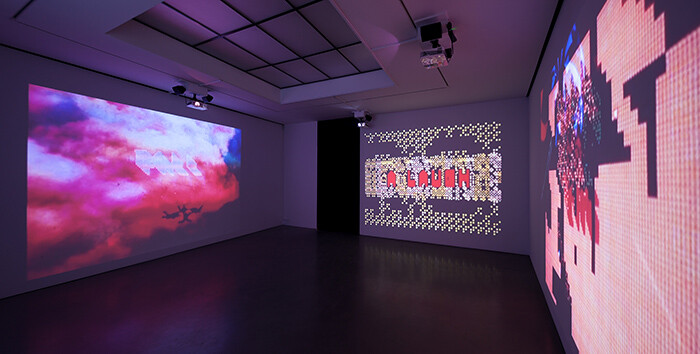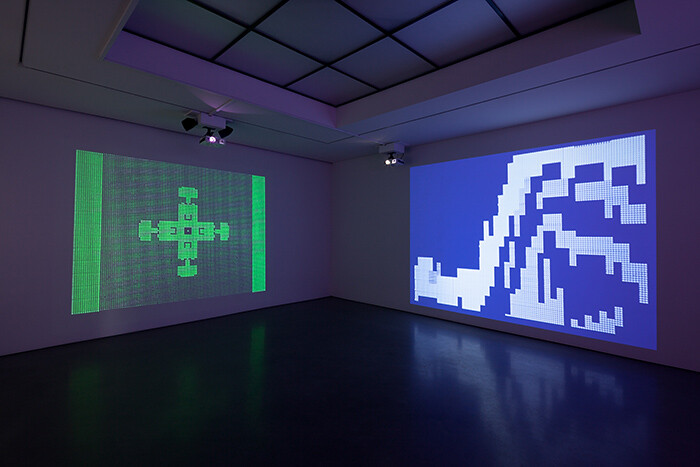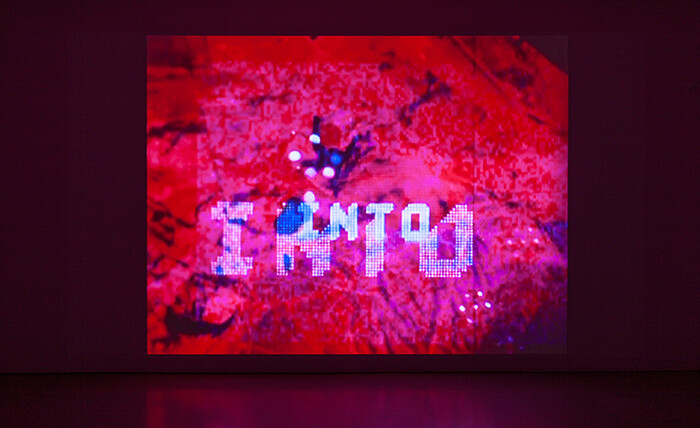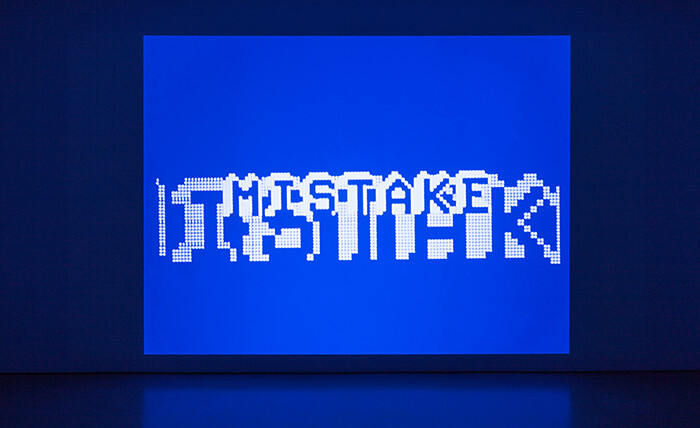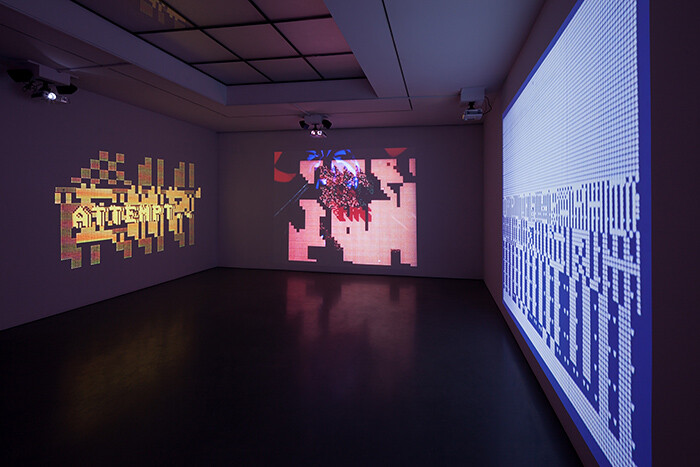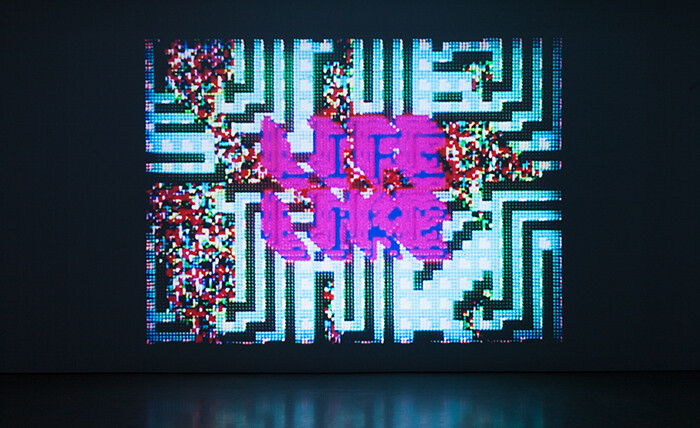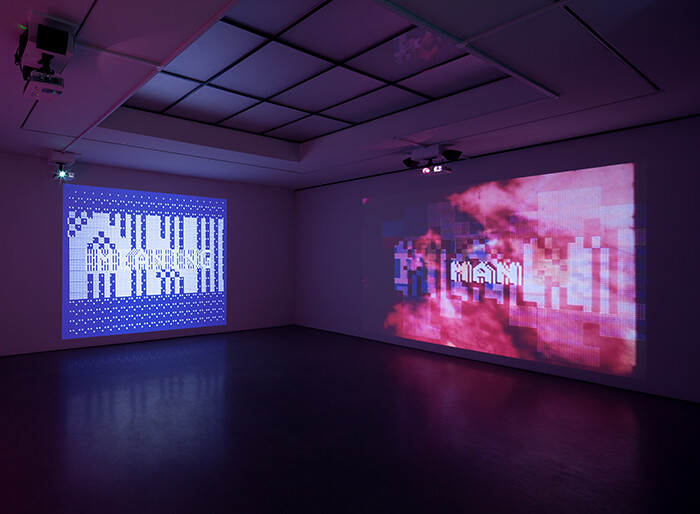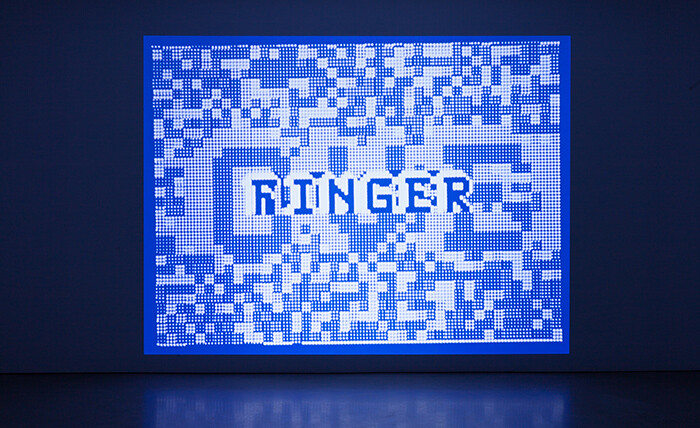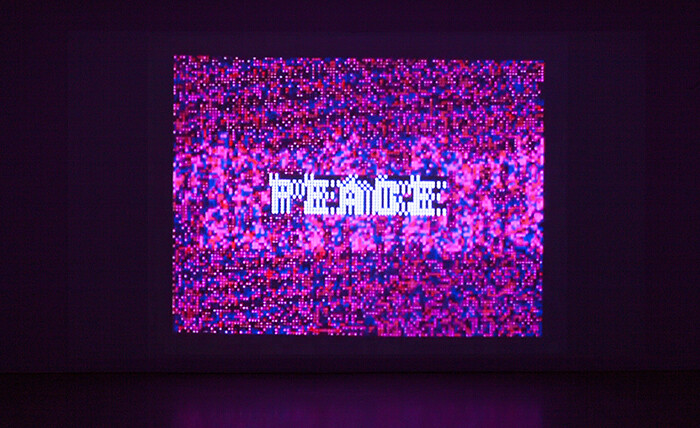Words pulsate, then bleed into abstraction. Fields of color fragment into pixels or smear into mutating organisms. Swarming text grids explode into chaotic rainbow clouds, blinking dots, stars, and spirals. Snaking orange lines and pointillist textures form strobing mandalas, mosaic embroidery, and Pac Man architecture, tumbling geometries of throbbing color that dissolve into blue, pink, yellow, and green pixel noise.
Five of the eight Poemfield films that Stan VanDerBeek made between roughly 1966 and 1971 return to us now at a moment in which the technologies of computation and image-making have all but inextricably fused. This transition seemed only just underway when VanDerBeek died in 1984, and yet the works that he created in collaboration with programmer and physicist Ken Knowlton at Bell Laboratories in Murray Hill, New Jersey, and then further developed during an artist residency at MIT’s Center for Advanced Visual Studies, look ahead to a full integration of cinema with computer imaging, attesting both to the artist’s prescience and to his devotion to a deeply syncretic notion of media.
VanDerBeek is frequently cited as the originator of the terms “expanded cinema” and “underground film,” and while his name is most closely associated with these spheres, his body of work extends into other art forms, exhibiting in institutional contexts far beyond those typically associated with the New American Cinema. Responding to the evolving and expanding mediascapes of the 1960s, VanDerBeek explored art and technology through unlikely collaborations with people from corporate and military realms. Fascinated by cybernetics and artificial intelligence, VanDerBeek was an advocate for artists’ access to proprietary hardware and expensive machinery—including not only computers, but videotape, lasers, and holography, as well—and his willingness to collaborate brought him not just to Bell Labs and MIT, but to NASA and Boston television station WGBH. Man and His World (1967), another collaboration with Knowlton, screened inside the geodesic dome that Buckminster Fuller design for Expo 67 in Montreal.
A key thesis of Gloria Sutton’s recent book, The Experience Machine: Stan VanDerBeek’s Movie-Drome and Expanded Cinema (2015), is that the artist’s work anticipates a contemporary network aesthetic, modeling new relationships among artistic and communications media. His major work—the partly realized Movie-Drome (1963), an expanded media exhibition space constructed inside a 30-foot grain silo—was itself a site for exploring new modes of networked image circulation. VanDerBeek described it as “a proto-type-cineman-space-stage [sic] … in which the audience will ultimately be able to control a considerable amount of the audio-visual presentation.”1 All of the Poemfield films—along with other films of his— were screened inside the Movie-Drome, a space of “image storage and retrieval” that one might now describe as an artisanal, site-specific YouTube channel.
This emphasis on new media as communication as well as artistic technologies explains the fundamentally textual nature of the Poemfield works. Here, the words and letters of the films’ fractured concrete poetry serve as message, image, and object all at once. Collaborating with composer John Cage (whom VanDerBeek studied with at Black Mountain College in the early 1950s) on words and sound in Poemfield No. 7 (1971), VanDerBeek crafts a topical poem out of paradox and disjunction: “There is no way to Peace – Peace is the way.” But other films seek out more associative plays on words and lettering: each is, to quote one of Poemfield No. 3’s word-images, “A MAP OF IDEAS” (1967).
In this sense, as Sutton emphasizes, the nature of the works is avowedly provisional. Each Poemfield film announces itself as a “Study in Computer Graphics,” and indeed all of the clean edges and shiny surfaces we associate with present-day computer graphics are absent from VanDerBeek’s films. As all were intended for projection and recombination in the Movie-Drome, there is the sense that each film is to a degree unfinished. As the series was not created in linear chronological order, and dates for each film also vary (thus No. 1 is exhibited here both in a monochrome white-on-blue version and a green/red/yellow-on-black one).
But this provisional quality is also reinforced by the hybrid nature of the films’ construction—each one mixes traditional celluloid and computer technology in a complex intermedia process that today seems almost impossibly laborious. To create each film, VanDerBeek would write out a set of instructions in BEFLIX (or “Bell Flicks”), a programming language written by Knowlton. These instructions would then be fed into an IBM 7094 interfaced with a microfilm recorder, which would film a black-and-white image that would later be edited, colorized, superimposed, or otherwise manipulated. Thus, the Poemfield films’ dynamic, psychedelic color palette was achieved not in the computer but through the vivid optical color effects of West Coast filmmakers Bob Brown and Frank Olvey, whose three-strip color dye separation method was actually closer to the early Technicolor process of the 1920s.2 Similarly, many of the films rely on superimpositions and layering to achieve multiple colors and illusions of depth and dimensionality. Poemfield No. 5 (1967) incorporates not only what looks like segments of one or more of the other Poemfield films, but also found documentary footage of skydivers, multiply superimposed over cascading columns of pixel blocks, number grids, and texts.
All of this—along with the two black-and-white embossed prints of VanDerBeek’s computer works also on view in the gallery—drives home the point that this was an emphatically material process, one that involved the complex relationship of material objects and techniques both computer-generated and mechanical. This fact inevitably presents challenges for gallery exhibition—exhibiting images made for a 252 by 184-pixel display, re-filmed on 16mm, transferred to digital video, and projected as a wall-sized image inside a white cube is complex enough, whether or not one attempts to approximate the cacophonous audiovisual environment of the Movie-Drome in a boxy architectural space. Nonetheless, true to VanDerBeek’s Gesamtkunstwerk, this installation of the Poemfield films makes for a comfortably enveloping (and overloading) environment for distracted viewing.
Stan VanDerBeek, “Movies … Disposable Art—Synthetic Media—& Artificial Intelligence,” Take One (January/February 1969): 16.
For more on the color process of VanDerBeek’s Poemfield films, see Gene Youngblood, Expanded Cinema (New York: P. Dutton & Co., 1970): 246ff; and Carolyn L. Kane, Chromatic Algorithms: Synthetic Color, Computer Art, and Aesthetics after Code (Chicago, IL: University of Chicago Press, 2014): 133.
